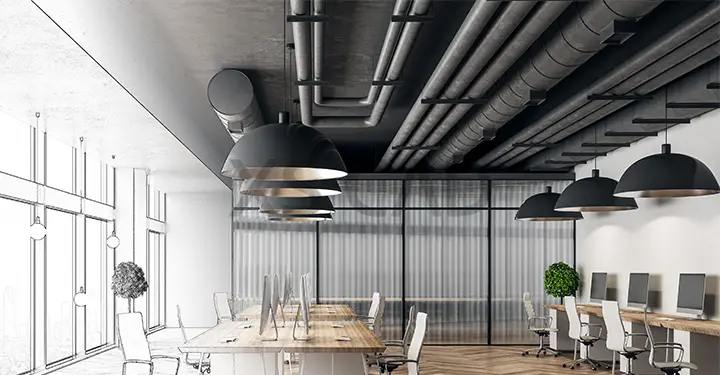Our Articles

What Building Engineering Design Trends Can We Expect in the Near Future?
Dynamic shifts in technologies are driving building engineering trends from today’s construction to tomorrow’s design concepts. Energy efficiency, sustainability and other such buzzwords are peppering conversations and revolutionising the way buildings are designed. Modern MEP design must incorporate these concepts with trusted and expert BIM services, electrical design services, fire sprinkler design services, HVAC ductwork design and the process of designing a plumbing system.
The future is here, and building construction is not to be left behind. Some of the latest trends in MEP include:
Building Smart
Integrating smart technologies in building systems was helped considerably with the advent of IoT (Internet of Things), sensors and automation. Today, buildings can be interconnected and managed remotely, resulting in improved energy efficiency, maintenance and comfort.
A Lot of IoT
The Internet of Things is witnessing exponential growth. Reportedly, there were in excess of 27 billion devices connected to the IoT in 2021. In the coming years, that number is expected to grow in leaps and bounds. The Industrial Internet of Things (IIoT), involving mechanical engineering in industrial complexes will add to the smart home use of IoT. To install IIoT systems, it is imperative to enable clear communication between old machinery and new sensors, which can be technically challenging.
Efficient with Energy Consumption
As part of the increasingly relevant sustainability and environmental narrative, energy-efficient MEP systems are very much in focus. Increased utilisation of geothermal heating and cooling, energy recovery ventilation and LED lighting will help reduce carbon footprints and lower costs.
Integrating Renewable Energy
It is becoming more important to integrate renewable energy sources such as solar, wind and geothermal energy systems into MEP designs to provide sustainable and clean alternatives, enabling buildings to generate their own electricity and reduce their dependence on fossil fuels.
Green Engineering
More the norm than the exception, green building practices in the MEP industry need new and functional sustainable design, construction and operations. Sustainability goals include achieving net zero emissions before 2050, and one of the ways forward include eco-engineering to create green engineering technologies.
Prefabrication and Modularisation
Improved quality control, reduced construction time and greater cost-effectiveness are some of the benefits of prefabrication and modularisation. By manufacturing MEP components and systems offsite and then installing them at the construction site, prefabrication and modularisation reduce on-site labour costs and other on-site overheads while minimising construction delays.
Building Information Modelling (BIM)
An essential tool in modern construction, 3D BIM modelling facilitates efficient communication and coordination among project stakeholders. Virtual models of building systems can be created accurately, and their performance can be visualised, while identifying potential clashes, leading to improved precision and reduced rework. It will be increasingly common to see the use of MEP BIM for sustainable construction also.
Healthy Environments
In search of wellness in buildings, MEP system design must focus on improved indoor air quality, thermal comfort and occupants’ health. Advanced HVAC systems with high-efficiency filters, demand-controlled ventilation and thermal comfort controls are fast becoming standard in today’s buildings, optimising occupant comfort, productivity and health.
Preparing for Natural Disasters
As natural disasters become increasingly frequent, resilient MEP systems are required to withstand and recover from extreme disruptions. MEP professionals must integrate disaster preparedness through the design of backup power systems, redundant systems and flood protection.
Retrofitting Retro Buildings

Retrofitting and upgrading existing or old buildings has become popular. The process of upgrading MEP systems in older buildings to be more efficient and sustainable can lead to significant energy savings, reduced costs and improved building performance.
The Addition of Additive Manufacturing
Additive manufacturing, also known as 3D printing, is revolutionising manufacturing processes globally, pushing the envelope to create sustainable and flexible materials and systems for customised 3D printing. This new trend will need mechanical engineers with expertise in design for additive manufacturing (DfAM) skills, as by 2030, the global 3D printing market is expected to be worth more than $51 billion.
New Avatars for CAD
The application for computer-aided design or CAD is currently changing and will continue to evolve in the future. Instead of using it exclusively for design, it may also be used for performance simulations, stress tests, generative design and digital twinning.
The Digital Twin
It can be time consuming and tedious to create physical models and prototypes, and small design changes may involve extensive rework. Digital twinning helps simplify the creation of physical models and prototypes. As a virtual model that accurately represents a real component or building, a digital twin can reflect virtual sensors, so that engineers can execute performance tests without creating new prototypes every time. Information amassed in the digital space can help perfect its twin in the real world.
These new trends will ultimately result in:
Experienced design partners can help make these new building engineering design trends not just a reality but a habit – a habit to progress.
To know more about building engineering design . . .
XS CAD has valuable experience providing BIM services and MEP BIM for sustainable construction for general contractors and consultants. Our range of services for consultants and across the world include designing a plumbing system, HVAC ductwork design, electrical design services, fire sprinkler design services and 3D BIM modelling, creating models and drawings by using Revit BIM, AutoCAD and BIM Collaborate Pro for cloud collaboration.

